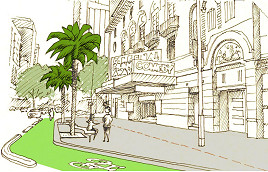Nightly truck procession to continue
Sleep-deprived CBD residents were offered little hope of respite from the hundreds of nightly trucks movements when the City of Melbourne discussed waste management last month.
Councillors on October 14 voted to continue to pursue a policy which has seen collection numbers reduced in three small areas where compactors have been installed.
In 2012 councillors were advised against attempting to mandate that the council be solely responsible for waste collection in the central city – fearing a backlash from the industry.
Every night some 30 waste and recycling companies send fleets of vehicles into the CBD resulting in a procession of trucks with reversing alarms lifting, emptying, banging, crashing and compacting all night.
There is a truck curfew between 11pm and 6 am in three small areas, but it is open slather in the rest of the city.
In 2012 councillors were given three options to consider but overlooked the option that would have resulted in a single collection service throughout the city.
Officers advised at the time that it would need the co-operation of the State Government to change legislation and that the industry would likey challenge such a move, on the basis that it would be anti-competitive.
At the time, councillors were told such a service would reduce congestion, noise and greenhouse gas emissions.
“Universal service should lead to maximum efficiency of truck movements for waste collection,” the officers’ report said.
Last month councillors voted to continue to develop an “integrated waste management program” which has had some success in reducing the number of collections in the areas surrounding Kirks, Bullens and Lacey lanes.
Engineering services manager Geoff Robinson was careful to point out that the reduction in the collections from these areas was not the intention of the program.
Rather, he said, the program was intended to reduce the amount of illegally dumped rubbish.
In speaking about the program, Cr Ken Ong acknowledged that: “private contractors were resisting this taking over of their space”.
A technical group of industry stakeholders is going to be established to set targets and directions for the council’s new waste strategy.
The new program will be presented to councillors next April.
The city is proud that it has succeeded in having more items recycled but, for residents, the down-side of this is even more collection trucks at night.
Residents 3000 president John Dall’Amico believes the solution to the amenity issue is to engineer a situation where each company has its own “territory”.
“At least then, there would be a single collection in an area each night,” Mr Dall’Amico said.
Cr Arron Wood said the council was working to alleviate the amenity issues by:
Introducing large waste compactor bins in laneways to replace smaller rubbish bins in areas of high density;
Introducing the restricted access zones;
Getting businesses to store bins inside;
Introducing communal recycling collections in designated areas;
Working with businesses to get them to share bins and choose one waste collector for a laneway; and
Stepping up education and enforcement efforts in laneways known for dumped rubbish.

Council endorses office tower at Flinders Lane despite querying car park demolition



 Download the Latest Edition
Download the Latest Edition